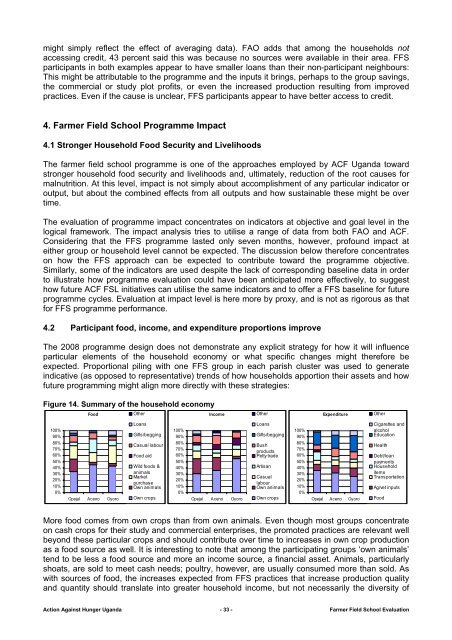Participatory Evaluation of our 2008 - Action Against Hunger
Participatory Evaluation of our 2008 - Action Against Hunger
Participatory Evaluation of our 2008 - Action Against Hunger
Create successful ePaper yourself
Turn your PDF publications into a flip-book with our unique Google optimized e-Paper software.
might simply reflect the effect <strong>of</strong> averaging data). FAO adds that among the households not<br />
accessing credit, 43 percent said this was because no s<strong>our</strong>ces were available in their area. FFS<br />
participants in both examples appear to have smaller loans than their non-participant neighb<strong>our</strong>s:<br />
This might be attributable to the programme and the inputs it brings, perhaps to the group savings,<br />
the commercial or study plot pr<strong>of</strong>its, or even the increased production resulting from improved<br />
practices. Even if the cause is unclear, FFS participants appear to have better access to credit.<br />
4. Farmer Field School Programme Impact<br />
4.1 Stronger Household Food Security and Livelihoods<br />
The farmer field school programme is one <strong>of</strong> the approaches employed by ACF Uganda toward<br />
stronger household food security and livelihoods and, ultimately, reduction <strong>of</strong> the root causes for<br />
malnutrition. At this level, impact is not simply about accomplishment <strong>of</strong> any particular indicator or<br />
output, but about the combined effects from all outputs and how sustainable these might be over<br />
time.<br />
The evaluation <strong>of</strong> programme impact concentrates on indicators at objective and goal level in the<br />
logical framework. The impact analysis tries to utilise a range <strong>of</strong> data from both FAO and ACF.<br />
Considering that the FFS programme lasted only seven months, however, pr<strong>of</strong>ound impact at<br />
either group or household level cannot be expected. The discussion below therefore concentrates<br />
on how the FFS approach can be expected to contribute toward the programme objective.<br />
Similarly, some <strong>of</strong> the indicators are used despite the lack <strong>of</strong> corresponding baseline data in order<br />
to illustrate how programme evaluation could have been anticipated more effectively, to suggest<br />
how future ACF FSL initiatives can utilise the same indicators and to <strong>of</strong>fer a FFS baseline for future<br />
programme cycles. <strong>Evaluation</strong> at impact level is here more by proxy, and is not as rigorous as that<br />
for FFS programme performance.<br />
4.2 Participant food, income, and expenditure proportions improve<br />
The <strong>2008</strong> programme design does not demonstrate any explicit strategy for how it will influence<br />
particular elements <strong>of</strong> the household economy or what specific changes might therefore be<br />
expected. Proportional piling with one FFS group in each parish cluster was used to generate<br />
indicative (as opposed to representative) trends <strong>of</strong> how households apportion their assets and how<br />
future programming might align more directly with these strategies:<br />
Figure 14. Summary <strong>of</strong> the household economy<br />
Food<br />
Other<br />
Income<br />
Other<br />
Expenditure<br />
Other<br />
100%<br />
90%<br />
80%<br />
70%<br />
60%<br />
50%<br />
40%<br />
30%<br />
20%<br />
10%<br />
0%<br />
Opejal Aceno Oyoro<br />
Loans<br />
Gifts/begging<br />
Casual lab<strong>our</strong><br />
Food aid<br />
Wild foods &<br />
animals<br />
Market<br />
purchase<br />
Own animals<br />
Own crops<br />
100%<br />
90%<br />
80%<br />
70%<br />
60%<br />
50%<br />
40%<br />
30%<br />
20%<br />
10%<br />
0%<br />
Opejal Aceno Oyoro<br />
Loans<br />
Gifts/begging<br />
Bush<br />
products<br />
Petty trade<br />
Artisan<br />
Casual<br />
lab<strong>our</strong><br />
Own animals<br />
Own crops<br />
100%<br />
90%<br />
80%<br />
70%<br />
60%<br />
50%<br />
40%<br />
30%<br />
20%<br />
10%<br />
0%<br />
Opejal Aceno Oyoro<br />
Cigarettes and<br />
alcohol<br />
Education<br />
Health<br />
Debt/loan<br />
payments<br />
Household<br />
items<br />
Transportation<br />
Ag/vet inputs<br />
Food<br />
More food comes from own crops than from own animals. Even though most groups concentrate<br />
on cash crops for their study and commercial enterprises, the promoted practices are relevant well<br />
beyond these particular crops and should contribute over time to increases in own crop production<br />
as a food s<strong>our</strong>ce as well. It is interesting to note that among the participating groups ‘own animals’<br />
tend to be less a food s<strong>our</strong>ce and more an income s<strong>our</strong>ce, a financial asset. Animals, particularly<br />
shoats, are sold to meet cash needs; poultry, however, are usually consumed more than sold. As<br />
with s<strong>our</strong>ces <strong>of</strong> food, the increases expected from FFS practices that increase production quality<br />
and quantity should translate into greater household income, but not necessarily the diversity <strong>of</strong><br />
<strong>Action</strong> <strong>Against</strong> <strong>Hunger</strong> Uganda - 33 - Farmer Field School <strong>Evaluation</strong>

















